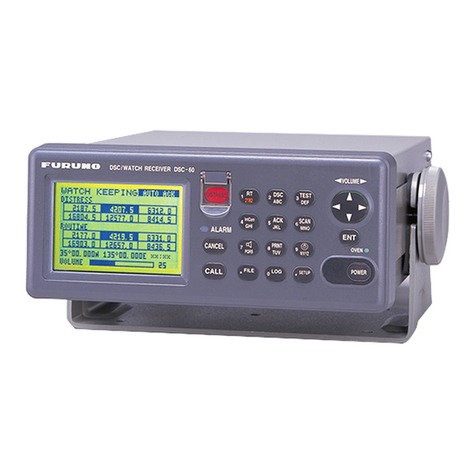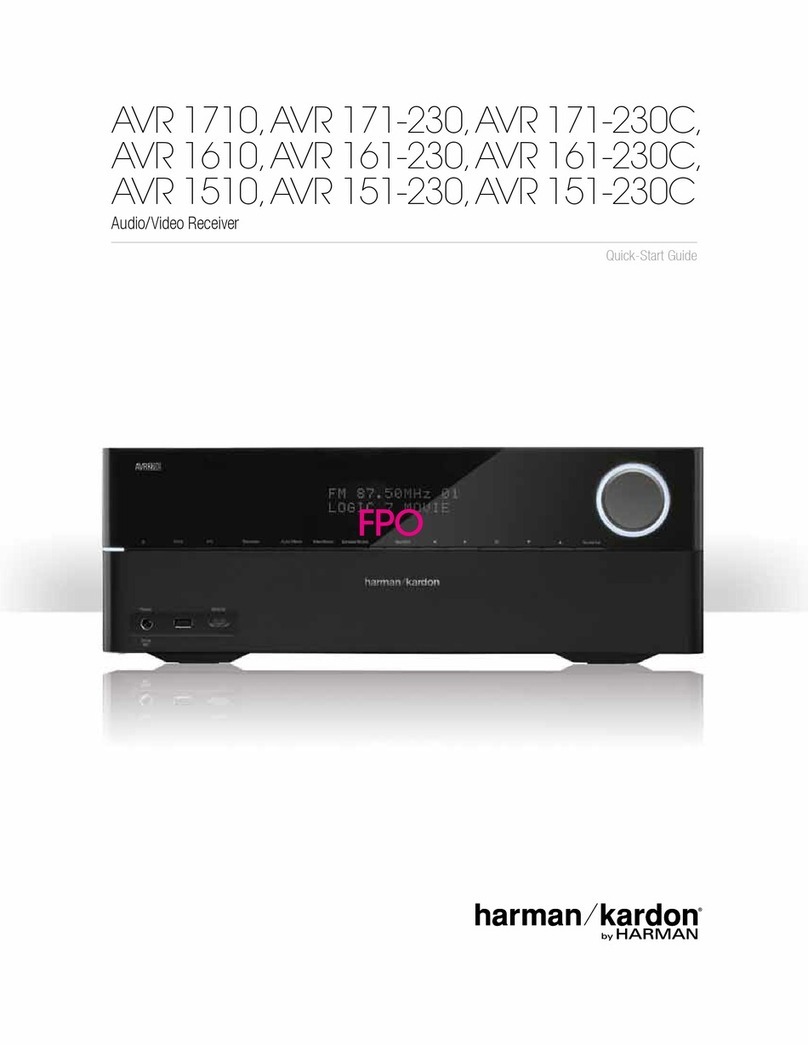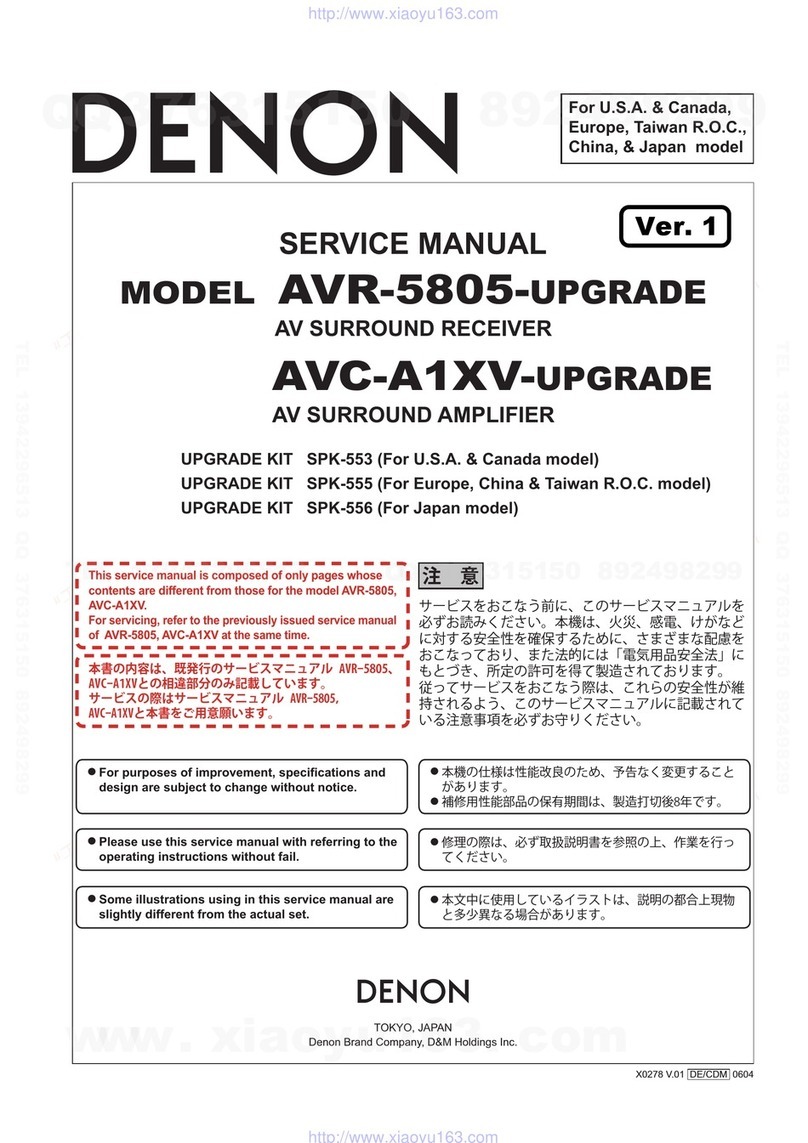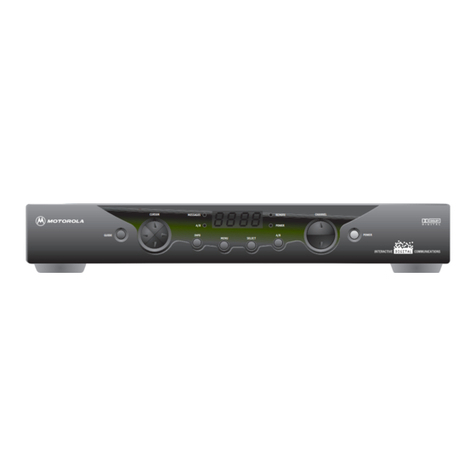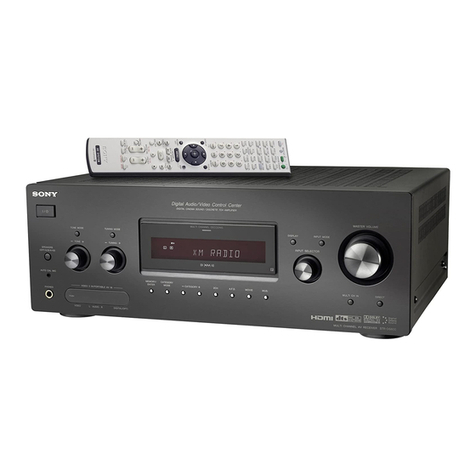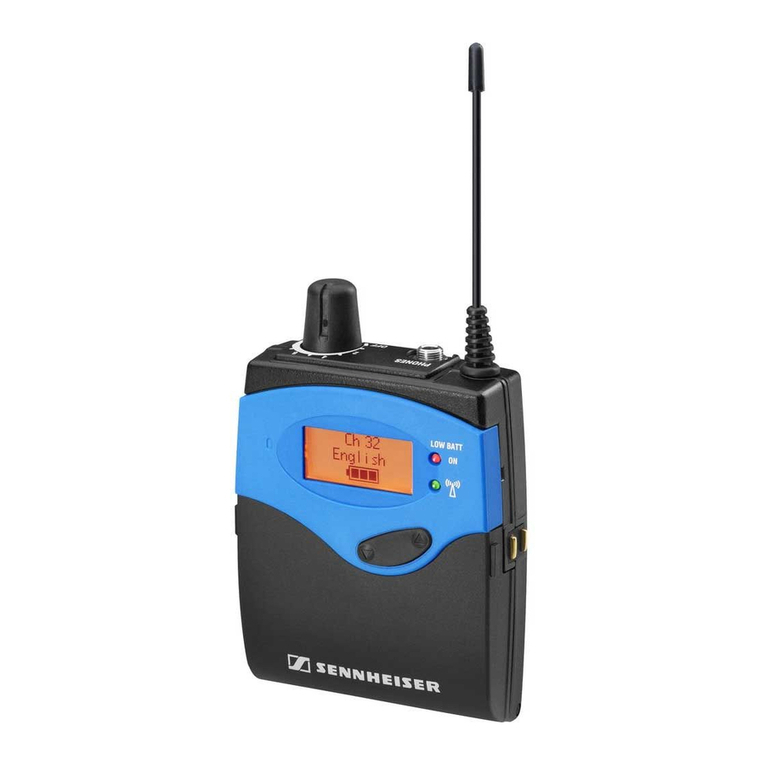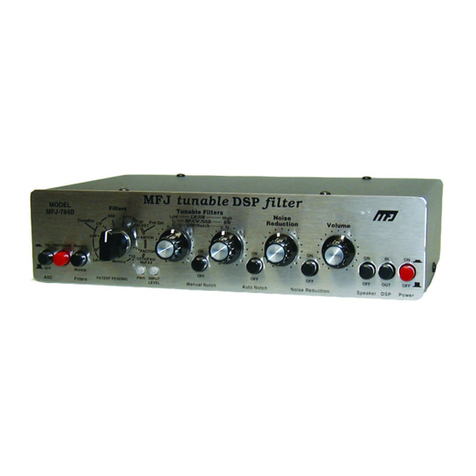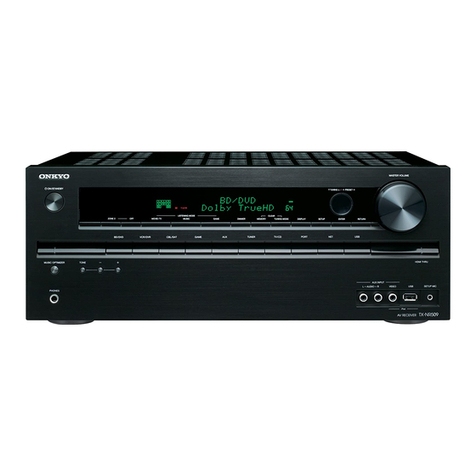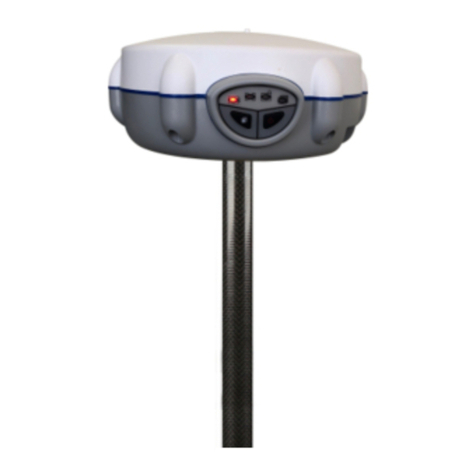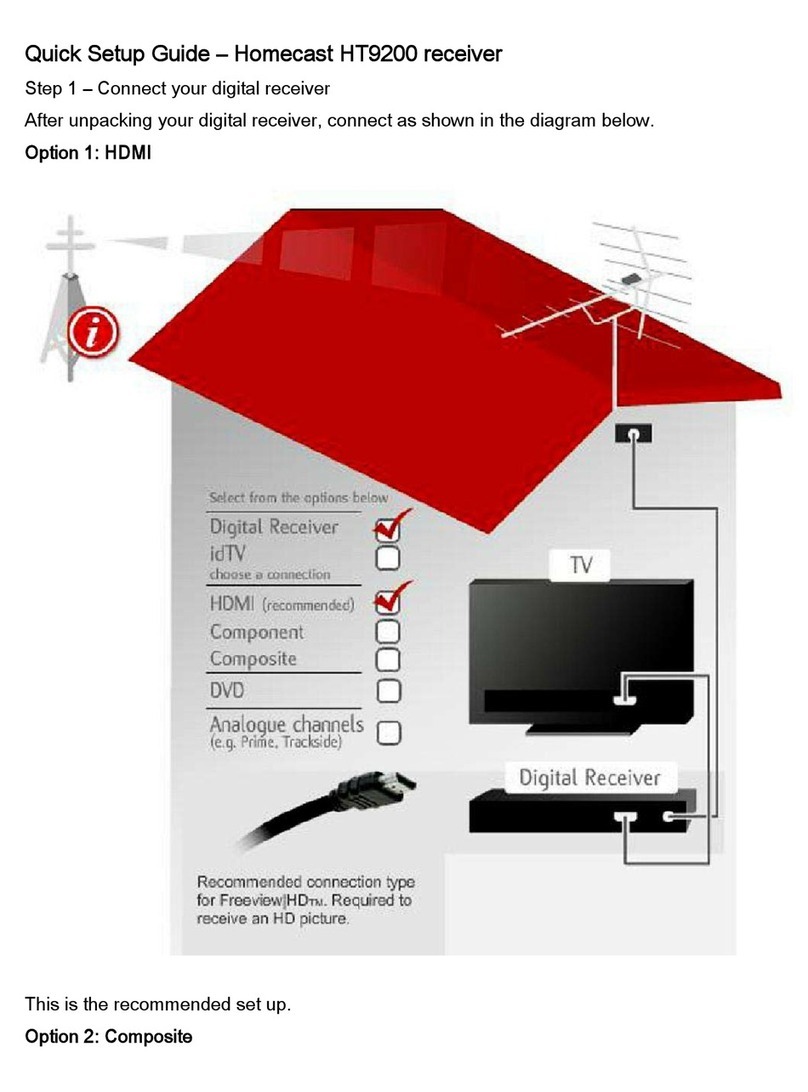Newport 2151 User manual

USER’S GUIDE
Visible & IR Femtowatt
Photoreceivers
Models 2151 & 2153
215x revC.fm Page 1 Tuesday, May 21, 2002 11:04 AM
phone: (877) 835-9620
e-mail: tech@newport.com • www.newport.com
These photoreceivers are sensitive to
electrostatic discharges and could be
permanently damaged if subjected to any
discharges. Ground yourself adequately
prior to handling these detectors or making
connections. A ground strap provides the
most effective grounding and minimizes the
likelihood of electrostatic damage.

215x revC.fm Page 2 Tuesday, May 21, 2002 11:04 AM
Warranty
Newport Corporation guarantees its products to be free of defects for one
year from the date of shipment. This is in lieu of all other guarantees,
expressed or implied, and does not cover incidental or consequential loss.
Information in this document is subject to change without notice.
Copyright 2022, Newport Corporation. All rights reserved.
The New Focus logo and symbol are registered trademarks of Newport
Corporation.
Document Number 90099907 Rev. A

Models 2151 & 2153 Contents • 3
Contents
Operation 5
Introduction . . . . . . . . . . . . . . . . . . . . . . . . . . . . . . . . . . . . . . . . . . . 5
Quick Start . . . . . . . . . . . . . . . . . . . . . . . . . . . . . . . . . . . . . . . . . . . . . 6
Using the Photoreceivers . . . . . . . . . . . . . . . . . . . . . . . . . . . . . . . . 7
Frequency Response and Noise 11
Measuring Bandwidth. . . . . . . . . . . . . . . . . . . . . . . . . . . . . . . . . . 11
Measuring Noise. . . . . . . . . . . . . . . . . . . . . . . . . . . . . . . . . . . . . . . 11
Using the 215X with a Chopper. . . . . . . . . . . . . . . . . . . . . . . . . 14
Typical Frequency Response and Noise Spectra . . . . . . . . . 15
Using Filters and Optical Fiber 19
Characteristics 21
Physical Specifications . . . . . . . . . . . . . . . . . . . . . . . . . . . . . . . . . 21
Model 2151 Visible Femtowatt Photoreceiver . . . . . . . . . . . 22
Model 2153 IR Femtowatt Photoreceiver . . . . . . . . . . . . . . . . 23
Responsivity . . . . . . . . . . . . . . . . . . . . . . . . . . . . . . . . . . . . . . . . . . 24
Customer Service 25
Technical Support . . . . . . . . . . . . . . . . . . . . . . . . . . . . . . . . . . . . . 25
Service . . . . . . . . . . . . . . . . . . . . . . . . . . . . . . . . . . . . . . . . . . . . . . . . 25
215x revC.fm Page 3 Tuesday, May 21, 2002 11:04 AM

4 • Contents
215x revC.fm Page 4 Tuesday, May 21, 2002 11:04 AM
This page has been intentionally left blank

Models 2151 & 2153 Operation • 5
Operation
Introduction
The Newport Models 2151 and 2153 are battery-
powered photoreceivers with an extremely high-gain
amplifier, making them ideal for low-light-level
detection applications, such asspectroscopy and
fluorescence measurements. They can detect optical
signals in the sub-picowatt to 0.5 nanowatt range, and
when used with a chopper and lock-in amplifier to
reduce the measurement bandwidth, these
photoreceivers can achieve sensitivity levels in the
femtowatt range.
The Model 2151 has a 1-mm-diameter silicon PIN
photodetector and can detect light from 300 to
1050 nm. The Model 2153 has a 1-mm-diameter
InGaAs PIN photodetector and operates from 800 to
1700 nm. Typical responsivity curves for the units can
be found in the “Responsivity” section onpage 24.
The circuitry inside the Model 215X consists of a
photodetector followed by an electronic gain stage.
The incredibly high gain and low-noise performance
of these photoreceivers was achieved by careful
selection and design of the amplifier-resistor pair. A
large feedback resistor is used to achieve the high
transimpedance gain values while an ultra-quiet
amplifier keeps noise to a minimum. A simplified
schematic of the Model 215X circuitry is shown in
Figure 1.
215x revC.fm Page 5 Tuesday, May 21, 2002 11:04 AM

6 • Operation
Figure 1:
Functional
schematic of
the Model 215X
circuitry
The femtowatt photoreceiver has three gain/
bandwidth settings: DC Low, AC Low, and AC High.
The Low gain setting has 2×1010 V/A transimpedance
gain, and the High gain setting has 2×1011 V/A gain.
The bandwidth of the DC setting is DC to 750 Hz, and
the two AC settings have a 30 to 750 Hz bandwidth.
For the AC settings the low-frequency roll-off at 30 Hz
helps to reduce DC offsets and drift. The label on the
front of the case summarizes the various gain and
bandwidth values for the three settings.
The Model 215X runs off a single 9-volt alkaline
battery and does not require a high-voltage power
supply or a cooling system. So, in some applications
the Model 215X can be used as a simple substitute for a
photomultiplier tube. The BNC connector and the
switches are conveniently located on the top of the
photoreceiver for easy access and to minimize the
thickness of the housing so it can fit in tight spaces.
Diagrams and specifications for the Model 215X femtowatt
photoreceiver can be found in the “Characteristics” chapter
beginning on page 21.
Quick Start
1. Check the battery voltage. The Model 215X is
powered by a single 9-volt alkaline battery. To
check the battery condition, push the red power
switch to the BATT CHK position. If the green LED
lights up, the battery is in good condition; if the
OFF
ON
Output
109 V/A
LED
AC High
AC Low
DC Low
Battery Check
Circuit
Batt
Chk
x200
x20
x20
Note:
Note:
215x revC.fm Page 6 Tuesday, May 21, 2002 11:04 AM

Models 2151 & 2153 Operation • 7
LED does not light, the battery needs to be
replaced (see page 8).
2. Mount the photoreceiver. Use the 8-32 thread
(M4 for metric versions) on the bottom of the
casing to mount the photoreceiver to a post or
pedestal.
The threading is seated in a non-conductive plastic pad to
reduce the electrical noise associated with ground loops. Be
careful not to over-tighten when attaching the casing to a
post or pedestal, or the threaded insert can strip out of the
plastic pad.
3. Turn the power switch to “on.” The output
voltage should appear at the BNC connector.
4. Adjust the gain. Use the black switch on top of
the receiver to set the gain DC Low, AC Low, and
AC High. The bandwidths vary with the gain
setting (the label on the front of the photoreceiver
indicates the gain and bandwidth values).
5. Turn the receiver off. When you are finished
with the receiver, return the power switch to the
“off” position.
Using the Photoreceivers
Checking the Battery
The Model 215X is powered by a single, standard
9-volt alkaline battery. Under normal operating
conditions with low light levels and a high impedance
load attached to the BNC connector, the photoreceiver
draws about 2.5 mA from the battery, and the battery
lifetime is approximately 200 hours.
To check the condition of the battery, push the red
power switch to the BATT CHK position. If the green
LED lights up, the battery is in good condition.
215x revC.fm Page 7 Tuesday, May 21, 2002 11:04 AM

8 • Operation
When the battery voltage falls below about 6.5 volts,
the green LED will not light up, and the battery should
be replaced.
Replacing the Battery
1. Turn the red power switch to “off” to prevent
damage to the receiver.
2. Remove the screw on the back of the photore-
ceiver casing and remove the back cover.
3. Unplug the old battery by rotating it away from
the circuit board about the snap-on terminal
contacts
4. Install a new 9-volt alkaline battery.
5. Reinstall the back cover and screw.
6. Test the new battery’s status by pushing the
power switch to the BATT CHK position.
Detecting Light
Optical Power and Output Voltage
The typical operating range for these receivers is from
femtowatts up to 0.22 to 0.5 nanowatts, where the
amplifier will saturate. Be careful to keep the optical
power under the maximum optical power of 10 mW
to avoid damaging the photodetector.
To compute the approximate output voltage for a
given input optical power use the relationship
Vout = Pin·R·G
where Pin is the input optical power in watts, Ris the
photodetector’s responsivity in A/W (see page 24 for
typical responsivities), and Gis the amplifier’s trans-
impedance gain in V/A.
For example, the Model 2151 on the DC Low gain
setting and with 0.1 nW of optical power at 900 nm
215x revC.fm Page 8 Tuesday, May 21, 2002 11:04 AM

Models 2151 & 2153 Operation • 9
will have an output voltage of approximately
(0.1 nW)·(0.5 A/W)·(2×1010 V/A) = 1 V.
The maximum optical power that can be detected by
the photoreceiver is determined by the input optical
power at which the transimpedance gain stage
saturates. We can calculate the saturation power at
900 nm for the Model 2151 assuming a maximum
output voltage of 5 volts. (The output can typically
generate greater than 5 volts, but to be conservative we
assume a maximum output of 5 volts.)
Using the expression 5 V = Psat·R·G, the Model 2151 has
a saturation power of 0.5 nW for the DC Low and
AC Low gain settings and 0.05 nW for the AC High
gain setting. At other wavelengths where the
responsivity is lower, the saturation power increases
inversely with responsivity.
Shielding the Photodetector
Since the femtowatt photoreceivers have extremely
high sensitivity, you should to be careful to shield the
photodetector from any unwanted light sources. The
simplest technique is to use baffling or other physical
barriers such as black cloth or opaque beam tubes to
block stray light. Use of the Model 1280 1" filter holder
(see page 19) with appropriate optical bandpass filters
is also highly recommended.
To illustrate the problems that can be caused by even a
low power point source far from the photoreceiver,
take a look at the following calculation:
where ris the photodiode radius, Ris the distance from
a point source to the photodiode, Pois the power
emitted from a point source, and Preceived is the power
which will be incident on the photodiode from that
point source at that distance.
Preceived Poπr2
4πR2
-------------1
4
---Por
R
---
20.25 1mW 0.5mm
1m
----------------
20.06nW
˙
=⋅⋅== =
215x revC.fm Page 9 Tuesday, May 21, 2002 11:04 AM

10 • Operation
Notice that with a responsivity of 0.5 A/W and
transimpedance gain of 2×1010 V/A, a 1-mW point
source (such as a bright LED) at a distance of 1 meter
gives an output voltage of 0.6 V. This illustrates that
you cannot be too careful to exclude extraneous
optical signals when you want to measure power at
femtowatt levels.
Since stray light typically has its strongest frequency
components at DC and line frequency harmonics,
optical chopping and synchronous detection
techniques are quite valuable for improving your
measurement sensitivity.
AC versus DC Settings
The internal circuitry of the femtowatt photoreceiver
consists of a two-stage amplifier (see Figure 1). The
first stage is a transimpedance amplifier with a fixed
gain of 109V/A. The second stage is a variable-gain
voltage amplifier with the following three settings:
1. Gain of 20, DC-coupled amplifier
2. Gain of 20, AC-coupled amplifier
3. Gain of 200, AC-coupled amplifier
The AC-coupled amplifier uses a passive RC high-pass
filter with a corner frequency of 30 Hz. This stage may
still result in some small DC-level output, depending
on the DC offset of the amplifier.
Keeping this two-stage circuit in mind, you will not be
confused by saturation of the first stage amplifier. If
your DC light level is sufficient to saturate the first
stage amplifier, AC signals will be reduced, distorted,
or removed entirely by the saturation effects.
Switching to an AC output under these conditions will
not recover the AC signal which is lost in the first stage.
The recourse under these conditions is to reduce the
optical power level.
215x revC.fm Page 10 Tuesday, May 21, 2002 11:04 AM

Models 2151 & 2153 Frequency Response and Noise • 11
Frequency Response and Noise
Measuring Bandwidth
The frequency response and noise characteristics of
the femtowatt photoreceiver depend on the selected
gain. Figures 2 and 3 on the following pages give the
typical frequency response and noise behavior for the
photoreceivers at each of the three gain settings—DC
Low, AC Low, and AC High. The frequency response of
the transimpedance gain is plotted using the expression
where ƒis the frequency and Gain(0) is the gain at DC.
The photoreceiver’s bandwidth is defined as the
frequency where the gain has decreased by 3 dB, or a
factor of .
Measuring Noise
The photoreceiver noise is characterized using the
noise equivalent power (NEP), which is a measure of
the weakest optical signal that the photoreceiver can
detect. The NEP is the optical power which will
produce a signal-to-noise ratio of 1 in a 1-Hz
bandwidth. The minimum detectable optical power
can be found using the relationship
Minimum Optical Power = NEP · ,
where BW is the bandwidth. Note that NEP is a
wavelength-dependent quantity that changes with the
photodetector’s responsivity.
20 Gain f()
Gain 0()
---------------------
log⋅
2
BW
215x revC.fm Page 11 Tuesday, May 21, 2002 11:04 AM

12 • Frequency Response and Noise
Another way to characterize the noise is with the
photocurrent noise (In), which is related to NEP by
In= R · NEP
where Ris the photodetector’s responsivity. The
photocurrent noise is independent of wavelength
because it gives the photoreceiver’s noise with the
photodetector’s responsivity factored out.
To characterize the noise of the femtowatt
photoreceivers, the output electrical noise spectrum is
measured with a spectrum analyzer. This voltage noise
spectrum is converted to an equivalent optical
photocurrent noise by dividing the voltage noise by
the transimpedance gain (V/A). The photocurrent
noise, In(ƒ), has units of fA/ and is plotted in
Figures 2 and 3 using the expression 20·log[In(ƒ)/1 A].
Calculating NEP
The noise equivalent power (NEP) can be calculated by
dividing the photocurrent noise by R, the detector’s
responsivity (see Figure 6 on page 24).
For instance, the Model 2151 on the DC Low gain
setting has a minimum photocurrent noise of
6 fA/ (see Figure 2c). When operating around
900 nm where the responsivity is about 0.5 A/W, the
NEP is 12 fW/ .
The integrated noise equivalent power from DC to
750 Hz is then obtained by multiplying the average
NEP by , the square root of the bandwidth. The
expression BW = 2
π
ƒ3-dB/4 for a one-pole low-pass
filter is useful for calculating the equivalent noise
bandwidth. For the Model 215X with a 3-dB
bandwidth of 750 Hz, the equivalent noise bandwidth
is BW = 1200 Hz.
This gives an optical noise equivalent power of about
0.4 pW, which means that the minimum detectable
optical signal (with a signal-to-noise ratio of 1 and the
Hz
Hz
Hz
BW
215x revC.fm Page 12 Tuesday, May 21, 2002 11:04 AM

Models 2151 & 2153 Frequency Response and Noise • 13
full 750 Hz bandwidth) for the Model 2151 on the DC
Low setting with 900 nm light is 0.4 pW. “Using the
215X with a Chopper” on page 14 discusses using an
optical chopper and a lock-in amplifier to reduce the
minimum detectable power to much lower levels.
Calculating Output-Voltage Noise
The output-voltage noise can be calculated from
G · R · NEP ·
where Gis the transimpedance gain (V/A), Ris the
photodiode responsivity (A/W), NEP is the average
noise equivalent power, and BW is the bandwidth. This
gives an output noise voltage for the Model 2151 on
the DC Low setting of (2×1010 V/A) · (0.5 A/W) ·
(12 fW/ )· (1200 Hz)1/2 = 4 mVrms.
Something to consider when determining the noise
limits is that there can be other environmental sources
of noise in a measurement. The most likely noise
source you will encounter when using the femtowatt
photoreceiver is unwanted optical signals. It will be
extremely helpful to use optical filters and a layout
which prevents stray light from reaching the
photoreceiver.
Summary
To summarize, the NEP is 12 fW/ for the Model
2151 on the DC Low setting, and this yields an output
noise voltage of 4 mVrms. Viewed another way, for
operation at the peak responsivity wavelength of
900 nm and for the DC Low gain setting, you will
achieve a signal-to-noise ratio of unity if the input
power is 0.4 pW. Note that this assumes operation
without any post-photoreceiver filtering and with the
full photoreceiver bandwidth of 750 Hz. By using an
electronic band-pass filter or an optical chopper and
lock-in detection, the minimum detectable optical
signal can be reduced significantly.
BW
Hz
Hz
215x revC.fm Page 13 Tuesday, May 21, 2002 11:04 AM

14 • Frequency Response and Noise
Using the 215X with a Chopper
Because the photocurrent in the femtowatt
photoreceiver is generated in a photodiode, and the
gain is set by fixed resistors, the output voltage under
steady illumination is quite stable. Therefore, for many
applications, you may read the photoreceiver’s output
directly. This gives you a measurement bandwidth of
750 Hz, or a time resolution of about 1 msec. You can
easily reduce this bandwidth by low-pass filtering or
averaging the output voltage to get improved noise
performance.
When noise reduction beyond what low-pass filtering
can provide is needed, you must find a way to limit the
measurement bandwidth. One common technique is
to use an optical chopper and synchronous detection.
The chopper technique will be particularly useful
because an interfering optical noise source can be
differentiated from the desired optical signal by
passing the desired optical beam through a chopper.
The chopper should be run at a frequency lower than
the 750-Hz bandwidth of the femtowatt photoreceiver.
Because many interfering optical signals and residual
noise in amplifier electronics occur at harmonics of
the line-power frequency, your chopper should be set
to avoid these frequencies. For instance, the chopper
can be run at 470 Hz, using a synchronous detection
with a two-pole lock-in amplifier time constant of
1 second. Now the collected data is limited to a
bandwidth of 0.125 Hz, and the photoreceiver noise
contribution is reduced to an integrated noise
equivalent power of 4.2 fW at peak responsivity
(visible), or 7.8 fW for the Model 2153 infrared
photoreceiver. Excess optical noise contributions with
frequency components outside of the 0.125-Hz
window around 470 Hz are rejected.
215x revC.fm Page 14 Tuesday, May 21, 2002 11:04 AM

Models 2151 & 2153 Frequency Response and Noise • 15
Typical Frequency Response and Noise Spectra
The 3-dB frequency bandwidth is defined as the
frequency where the Model 2151’s transimpedance
gain has decreased by a factor of . For the Model
2151 on the DC Low setting the gain is 2×1010 V/A,
and the bandwidth is DC–750 Hz. The AC Low setting
has the same gain, and the bandwidth is 30–750 Hz.
The gain on the AC High setting is 2x1011 V/A, and the
bandwidth is 30–750 Hz. The noise spectrum is
plotted in units of photocurrent noise, fA/ .
Figure 2:
Typical
frequency
response and
noise spectra
for the Model
2151 with the
gain set to
(a) DC Low,
(b) AC Low, and
(c) AC High.
2
Hz
10 100 1000
6 fA/√Hz
Frequency, Hz
Frequency Response
Noise
10 dB/div
10 100 1000
6 fA/√Hz
Frequency, Hz
Frequency Response
Noise
10 dB/div
(a) DC Low
(b) AC Low
215x revC.fm Page 15 Tuesday, May 21, 2002 11:04 AM

16 • Frequency Response and Noise
For the Model 2153 on the DC Low setting the gain is
2×1010 V/A, and the bandwidth is DC–750 Hz. The AC
Low setting has the same gain, and the bandwidth is
30–750 Hz. The AC High setting has a 2×1011 V/A gain,
and the bandwidth is 30-750 Hz. The noise spectrum
is plotted in units of photocurrent noise, fA/ .
Figure 3:
Typical
frequency
response and
noise spectra
for the Model
2153 with the
gain set to
(a) DC Low,
(b) AC Low, and
(c) AC High.
10 100 1000
8 fA/√Hz
Frequency, Hz
Frequency Response
Noise
10 dB/div
(c) AC High
Hz
(a) DC Low
10 100 1000
22 fA/√Hz
Frequency, Hz
Frequency Response
Noise
10 dB/div
215x revC.fm Page 16 Tuesday, May 21, 2002 11:04 AM

Models 2151 & 2153 Frequency Response and Noise • 17
(b) AC Low
10 100 1000
22 fA/√Hz
Frequency, Hz
10 dB/div
Frequency Response
Noise
10 100 1000
23 fA/√Hz
Frequency, Hz
10 dB/div
Frequency Response
Noise
(c) AC High
215x revC.fm Page 17 Tuesday, May 21, 2002 11:04 AM

18 • Frequency Response and Noise
215x revC.fm Page 18 Tuesday, May 21, 2002 11:04 AM
This page has been intentionally left blank

Models 2151 & 2153 Using Filters and Optical Fiber • 19
Using Filters and Optical Fiber
Newport offers accessories that can be used for
attaching a 1"-diameter filter or an optical fiber to the
Model 215X femtowatt photoreceiver. These accessories
are sold separately, and they are not supplied with the
photoreceiver. Both accessories attach tothe unit
using the 1.04-32 threads located in the casing around
the photodetector. Note that the accessories are also
compatible with the Model 162X nanosecond
photodetector.
The Model 1280 1" filter holder (see Figure 4) allows a
1"-diameter optic to be mounted in front ofthe
photo-detector. For instance, you can mount a
colored glass filter to remove unwanted wavelengths
or attach a neutral-density filter to attenuate the
optical-power incident onthe photodetector. Since
the Model 215X has extremely high gain, using an
optical bandpass fil-ter to remove background optical
noise sources can help improve your measurement
sensitivity. The Model 1280 has a plastic ring for
mounting a filter that is up toabout 0.25" (6.4-mm)
thick, or a thicker optic can be held in place using the
6-32 nylon-tipped set screw. Use a 1/16" or 1.5-mm
Allen key or ball-driver toadjust the set screw.
The Model 1281 FC fiber adapter (see Figure 4) allows a
FC-connectorized fiber to be attached in front ofthe
photodetector. If you need fibers and accessories for
coupling light into optical fibers, a variety of fiber
couplers, fiber collimators and pigtails are available
from Newport.
215x revC.fm Page 19 Tuesday, May 21, 2002 11:04 AM

20 • Using Filters and Optical Fiber
Figure 4:
Model 1280
filter holder
and Model
1281 FC-fiber
adapter
0.63"
(15.9)
Model 1280
patent pending
dia. 1.30"
(33.0)
holes for
tightening
1.04-32
thread
Retaining ring
for holding 1"
or 25-mm optics.
6-32 nylon-tipped
setscrew for
holding 1" or
25-mm optics.
0.13"
(3.2)
FC connector
holes for
tightening
1.04-32
thread
0.35"
(8.9)
0.19"
(4.8)
Model 1281
215x revC.fm Page 20 Tuesday, May 21, 2002 11:04 AM
This manual suits for next models
1
Table of contents
Other Newport Receiver manuals
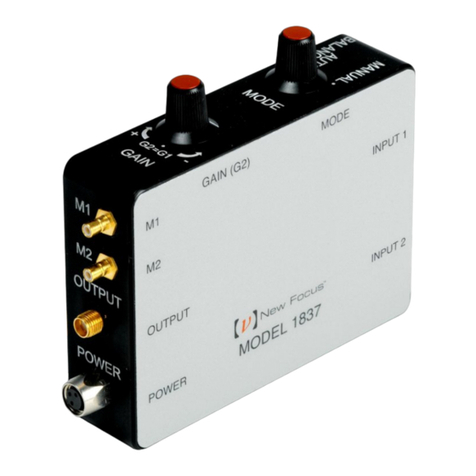
Newport
Newport NIRVANA User manual
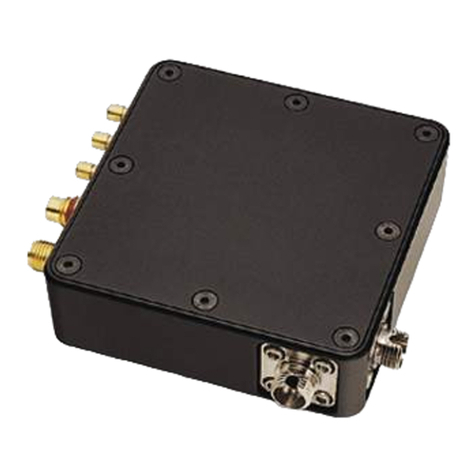
Newport
Newport 1607-AC User manual
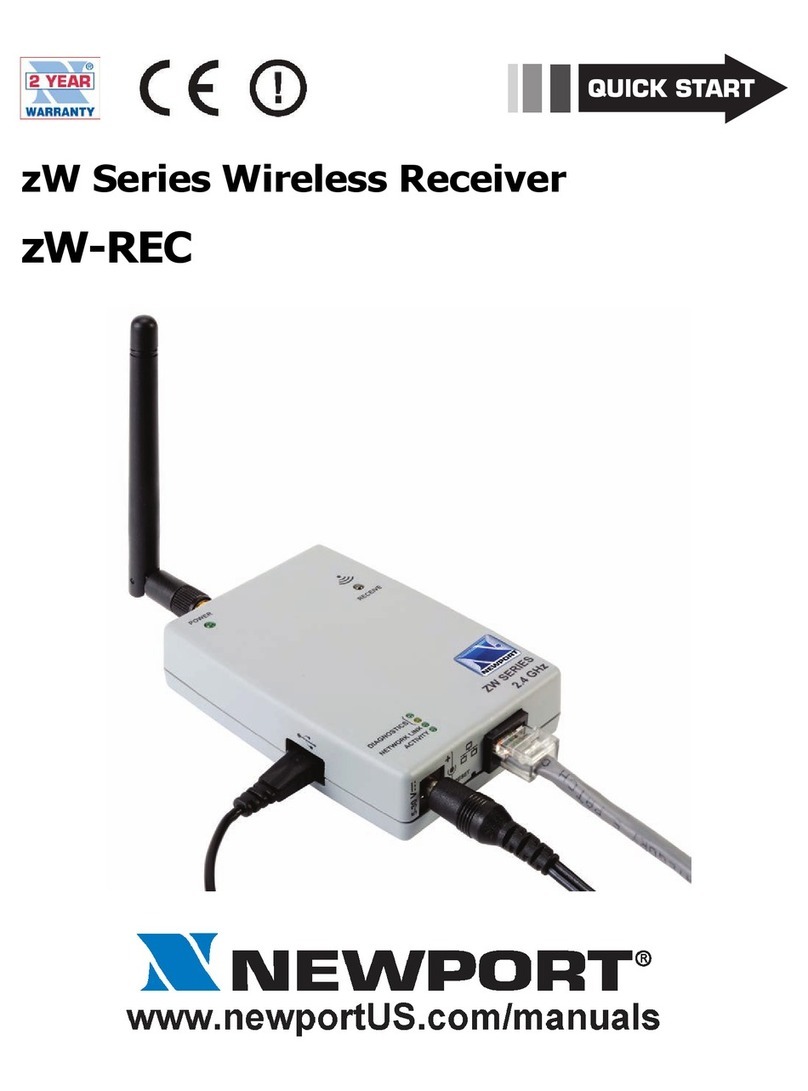
Newport
Newport zW Series User manual
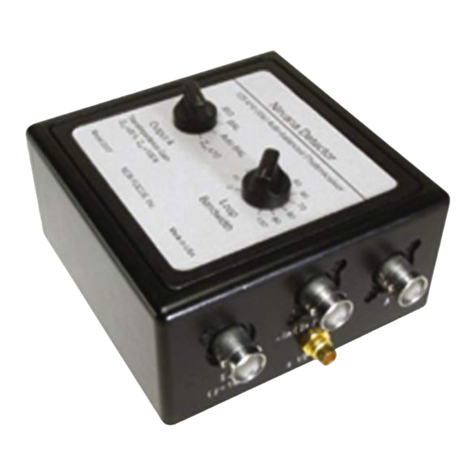
Newport
Newport 2007 User manual

Newport
Newport 1801 User manual
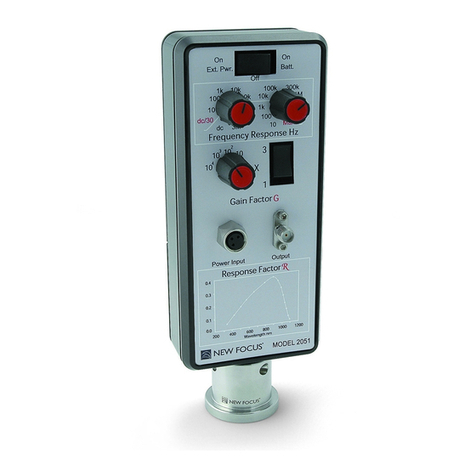
Newport
Newport 2051 User manual
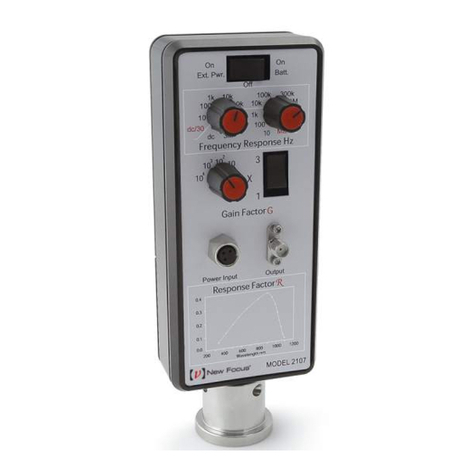
Newport
Newport 2107 User manual

Newport
Newport 1807 User manual
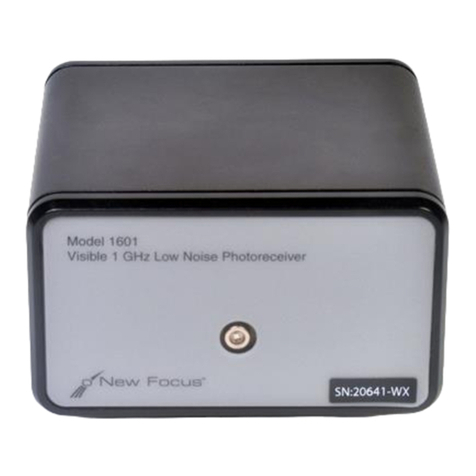
Newport
Newport 1601 User manual

Newport
Newport 1580-A User manual
